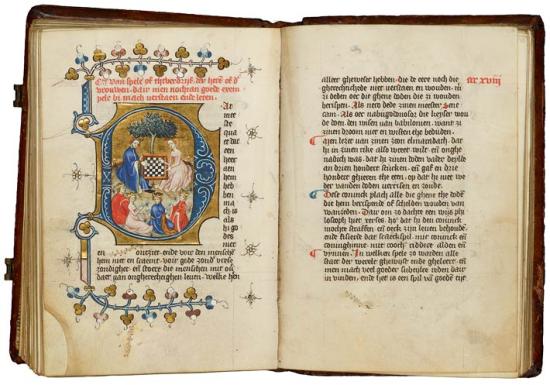
Table of Christian Faith, in Dutch
Illuminated by the Masters of Dirc van Delft
Purchased by J. P. Morgan, Jr., 1924
This is one of the earliest copies of the encyclopedia that van Delf wrote during the early fifteenth century. The miniature opens the chapter on games deemed suitable for royals; chess was considered an appropriate entertainment. A king and his queen play chess (although not with pieces, which the artist seems to have forgotten). He wears a luxurious fur-lined houpeland with a high neck and large bombard sleeves. His more humbly attired wife wears a simple cote hardy. A woman in a similar pink cote hardy plus two men and another woman in voluminous houpelands occupy the foreground.
Luxury in a Time of Madness
In 1392 King Charles VI suffered the first of forty-four bouts of madness that would cripple his reign. During a lull in the Hundred Years' War, strife between France and Burgundy erupted into civil war. This domestic crisis was sparked by the 1407 assassination of Charles's brother by Duke John of Burgundy. In 1419 the duke, in turn, was murdered by supporters of the crown. During these tumultuous times, fashion reached unbelievable heights of luxury.
Men's and women's fashions were dominated by a new garment, the houpeland. Men's houpelands featured enormous sleeves and a skirt ranging from full length to crotch level. The pourpoint remained popular, albeit often finely embroidered and equipped with large sleeves. Accessories included fancy baldricks (sashes) and belts—both sometimes hung with bells. Tall bonnets or chaperons, often tied into imaginative shapes, completed the look.
Women's houpelands were always full length, with bombard or straight sleeves. The simpler cote hardy, with its voluminous skirt and tight upper body, continued to be worn. Women began to wear their hair in temples, a double-horned coif surmounted by veils or a tubular burlet.
